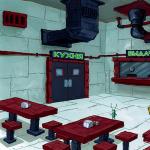Floor repair. Repair of self-leveling concrete floors
Defects in polymer flooring occur due to long-term operation, poor quality of the base, violation of the installation technology, as well as due to emergency impacts. Repair of the self-leveling floor is carried out after establishing the nature of the damage and finding out the causes of their occurrence.
Consider the types of plastic deformations of epoxy and polyurethane coatings, grouping them by nature and localization
Destruction of the polymer layer
In practice, they usually face 6 types of problems localized in the polymer itself:
Substrate Issues
Poor quality concrete screed , violation of the technology of installation of self-leveling polymeric floors, as well as unforeseen exposure to moisture, lead to the following consequences:

Results of emergency actions
Drops of heavy, pointed metal objects can cause chips and gouges in the floor, breaking the integrity of the concrete base. Pouring aggressive chemicals onto polymers with insufficient chemical resistance leads to the destruction of the coating to the full depth, to the concrete screed.
Defect Analysis
In cases where the nature of the damage does not indicate a low quality of the substrate, it is sufficient to determine the boundaries of the proposed repair using trial removal of the coating. In several places, it is necessary to measure the moisture content of the concrete screed to determine the full terms of reference for the upcoming work.
When analyzing the reasons for the peeling of the polymer layer, one should use not only a moisture meter, but also a hardness meter, as well as a building thermal imager. Only this device guarantees the detection of hidden sources of moisture in concrete.
Polymer coating repair technology
Depending on the type of defects, the repair of self-leveling floors includes surface treatment of the polymer layer, its removal, or dismantling along with a part of the concrete screed.
Cosmetic restoration
You can remove scratches visible to the eye and restore the original gloss of the epoxy coating by polishing. The operation is carried out by a rotary polishing machine with felt wheels, on which a special emulsion is applied.
Restoration of polyurethane floors is carried out by applying a protective varnish.
Any surface treatment is preceded by thorough cleaning, dedusting and degreasing.
Repair with removal of the polymer layer
In some cases, it is sufficient to remove only the upper layer of the polymer by grinding with diamond wheels. This is done when a coating with sagging, bubbles, surface discoloration is to be renovated. A new finish layer is poured onto the sanded surface. If the area of defects to be corrected is small, it is possible to do without an industrial rotary installation. For local grinding, a conventional hand-held angle grinder is used.
Repair of cracks and delaminations involves the complete removal of the polymer coating. In the case when the quality of the concrete substrate is not satisfactory, but they are going to remove the old fill over the entire area of \u200b\u200bthe room, the sequence of actions looks like this:
- Where the coating has poor adhesion, scraper-type punch nozzles are used for removal.
- In areas with preserved adhesion, chisel-type nozzles and grinders are used.
- The exposed surface of the concrete screed is sanded.
- A sequence of actions is performed that corresponds to the polymer floor installation technology: dedusting, degreasing, priming, applying the first layer, etc.
If the coating is removed in a limited area, then the perimeter of the repair work is first determined (it is made in the form of a rectangle). The pavement is then cut through to the concrete along this perimeter. Further work is carried out, as with the complete removal of the floor. The only difference is that the joints with the old coating are sanded and treated with special mastic.
What are the selection criteria: completely remove the coating or carry out local repairs?
If decorative properties are important (for example, in offices and shopping centers), then local repairs are appropriate even if the general condition of the surface is satisfactory. The decision to completely replace the polymer floor (regardless of the type of object) is made, as a rule, if more than 30% of the area of the self-leveling coating is damaged.
When replacing the coating locally, materials of the same type that have already been applied should be used. An exception is cosmetic repairs using methyl methacrylate mixtures. They work well in contact with other materials. The advantages of methyl methacrylates are the speed of work, the disadvantages are the low abrasive resistance.
Repairs affecting the concrete base
If the peeling of the polymer layers occurs due to the poor quality of the concrete substrate and the poor condition of the waterproofing, then it is impossible to do without altering the screed.
If, with a satisfactory quality of concrete, cracks in the screed are detected, the substrate should be restored. The traditional restoration technology consists in jointing cracks to the required depth, followed by dust removal, priming and filling with a polymeric repair compound.
Recently, an alternative technology called injection has begun to develop. First, the polymer layer is removed to completely expose the crack. Then, at an angle of 45 °, holes are drilled in the concrete towards the crack along its entire length with a step of 30-40 cm. Special fittings - packers are hermetically inserted into the holes. An injection pump is connected to the packers and a waterproofing compound is injected until it exits the fracture.
All repair actions after crack filling are similar to those described in the previous subsection.
Summary
Do not delay with the start of the repair. The price of delay is that instead of a cosmetic or local renovation, you will have to completely change the polymer coating.
Defects such as delamination or cracks tend to rapidly increase in size. But one should especially hurry in case of emergency chemical destruction of polymers. So that the reaction does not continue in the thickness of the material, it is necessary to limit the affected area and completely remove the polymer layer from it.
In what cases does it make sense to save on calling specialists and do-it-yourself repairs? The decision to carry out renovation on your own is economically justified when the proposed work is limited in area and does not require the rental of expensive equipment. For example, having carefully studied the technology of working with repair compounds and armed with a cutter, puncher, scrapers and an ordinary spatula, it is possible to replace the coating in small areas. But this only makes sense if the necessary materials are available for sale in exactly the quantity in which you need them.
Restoration options for self-leveling floors depend on the nature of the defects. It is worth considering in more detail possible breakdowns, the causes of defects and ways to eliminate them yourself or by calling a professional team.
Defects, causes of their occurrence, method of repair
Peeling of the polymer coating from the base

Peeling of the top layer of the coating together with the primer from the base surface is one of the most common types of defects. The reason is an obvious marriage in the production of work or the technology for pouring the coating was not followed, for example:
- the process of grinding / cleaning the surface was poorly performed to remove a weak layer of concrete, cement laitance, etc.;
- the procedure for dedusting the surface before priming was not carried out;
- the priming process was carried out on a wet, dirty base.
Do-it-yourself renewal option: dismantle the coating, clean and degrease the surface, pour in a new composition in strict accordance with the technological requirements. Cost when calling professionals from $15 per m².
Peeling of the coating from the ground without a ground layer
The reason is technological violations of the flooring process, for example:
- drying of the primer layer (before applying subsequent components) was more than 48 hours;
- pouring was carried out on a dirty primer layer (dust, water, dirt);
- the dew point has not been removed prior to coating the primer.
The repair technology is simple and with some skill, you can do it yourself: the surface needs to be degreased, cleaned. And after that, you can apply a polymer or self-leveling floor, following the recommendations established by the manufacturer. The cost of professional services is from $10 per m².
Elimination of cracks in the coating, exfoliated with a concrete layer of the screed

The reason is the low strength of the screed and a strong mechanical effect. Under such loads, a layer with high strength characteristics detaches from a weaker concrete base, forming cracks.
DIY repair options:
- dismantling of the polymer layer and impregnation of the top layer of the screed for maximum hardening;
- cutting down the concrete base on the cracked area and restoring it with repair compounds (sold in stores).
After that, the polymer coating is poured. When cracks appear over the entire area, it is necessary not to repair the floor with your own hands, but to call the masters to make a new screed with higher strength characteristics. Service price from $20 per m².
Wear of the polymer coating

The reason is the large load on the sites. It is formed in the places of baggage, the passage of transport carts, high traffic, and so on. Repair option - dismantling the old layer and pouring a new composition. Service price from $15 per m².
Loss of aesthetic qualities of the floor
The reason is the abrasion of the polymer layer from intense and prolonged loads. Do-it-yourself repair technology is simple - apply new polymers, after cleaning the old ones.
Chips, potholes

The reason is the mechanical impact of blunt or sharp heavy objects. Often whole fragments of the concrete base are chipped along with the polymer. Repairing defects with your own hands is possible, but difficult: cleaning, priming, puttying, coating. Professional service from $15-20 per m².
cracks

The appearance of cracks on the surface of the self-leveling floor, says that the reason is a concrete screed. The concrete base "weakened" and, for one reason or another, lost its strength qualities. The occurrence of cracks on the self-leveling floor as such is impossible! The composition is extremely mobile and flexible to crack. With small forms of defects, they can be primed, pre-expanded, puttied and painted over.
Important! If there are a lot of cracks, the technology of updating and repairing the self-leveling coating is useless. We need a call of specialists for the complete dismantling of the top layer and replacement of the concrete base. Issue price from $25 per m².
Technological features of the restoration of self-leveling floors
Do-it-yourself self-leveling floor repair or a team of professionals includes the following stages of technology work:
- Filling new layers on old ones. It is necessary to pre-wash and dry the old surfaces, sand and degrease. And then pour a new layer, creating a solution according to the instructions provided by the manufacturer.
- Repair of areas damaged to concrete also requires cleaning, grinding and drying. The polymer layer is poured strictly according to the instructions, including the priming operation.
Remember that only epoxy based materials are used to repair cracks in an epoxy floor. You can watch all the stages of work on the video, but it’s still better to call professionals. The cost of the service may vary depending on the complexity and volume of work. But even at a cost of $25 per m², you will get a new beautiful floor in a short time, and not a bunch of problems, a waste of money and nerves.
Defects in polymer flooring occur due to long-term operation, poor quality of the base, violation of the installation technology, as well as due to emergency impacts. Repair of the self-leveling floor is carried out after establishing the nature of the damage and finding out the causes of their occurrence.
Consider the types of plastic deformations of epoxy and polyurethane coatings, grouping them by nature and localization
Destruction of the polymer layer
In practice, they usually face 6 types of problems localized in the polymer itself:
Substrate Issues
Poor quality concrete screed , violation of the technology of installation of self-leveling polymeric floors, as well as unforeseen exposure to moisture, lead to the following consequences:

Results of emergency actions
Drops of heavy, pointed metal objects can cause chips and gouges in the floor, breaking the integrity of the concrete base. Pouring aggressive chemicals onto polymers with insufficient chemical resistance leads to the destruction of the coating to the full depth, to the concrete screed.
Defect Analysis
In cases where the nature of the damage does not indicate a low quality of the substrate, it is sufficient to determine the boundaries of the proposed repair using trial removal of the coating. In several places, it is necessary to measure the moisture content of the concrete screed to determine the full terms of reference for the upcoming work.
When analyzing the reasons for the peeling of the polymer layer, one should use not only a moisture meter, but also a hardness meter, as well as a building thermal imager. Only this device guarantees the detection of hidden sources of moisture in concrete.
Polymer coating repair technology
Depending on the type of defects, the repair of self-leveling floors includes surface treatment of the polymer layer, its removal, or dismantling along with a part of the concrete screed.
Cosmetic restoration
You can remove scratches visible to the eye and restore the original gloss of the epoxy coating by polishing. The operation is carried out by a rotary polishing machine with felt wheels, on which a special emulsion is applied.
Restoration of polyurethane floors is carried out by applying a protective varnish.
Any surface treatment is preceded by thorough cleaning, dedusting and degreasing.
Repair with removal of the polymer layer
In some cases, it is sufficient to remove only the upper layer of the polymer by grinding with diamond wheels. This is done when a coating with sagging, bubbles, surface discoloration is to be renovated. A new finish layer is poured onto the sanded surface. If the area of defects to be corrected is small, it is possible to do without an industrial rotary installation. For local grinding, a conventional hand-held angle grinder is used.
Repair of cracks and delaminations involves the complete removal of the polymer coating. In the case when the quality of the concrete substrate is not satisfactory, but they are going to remove the old fill over the entire area of \u200b\u200bthe room, the sequence of actions looks like this:
- Where the coating has poor adhesion, scraper-type punch nozzles are used for removal.
- In areas with preserved adhesion, chisel-type nozzles and grinders are used.
- The exposed surface of the concrete screed is sanded.
- A sequence of actions is performed that corresponds to the polymer floor installation technology: dedusting, degreasing, priming, applying the first layer, etc.
If the coating is removed in a limited area, then the perimeter of the repair work is first determined (it is made in the form of a rectangle). The pavement is then cut through to the concrete along this perimeter. Further work is carried out, as with the complete removal of the floor. The only difference is that the joints with the old coating are sanded and treated with special mastic.
What are the selection criteria: completely remove the coating or carry out local repairs?
If decorative properties are important (for example, in offices and shopping centers), then local repairs are appropriate even if the general condition of the surface is satisfactory. The decision to completely replace the polymer floor (regardless of the type of object) is made, as a rule, if more than 30% of the area of the self-leveling coating is damaged.
When replacing the coating locally, materials of the same type that have already been applied should be used. An exception is cosmetic repairs using methyl methacrylate mixtures. They work well in contact with other materials. The advantages of methyl methacrylates are the speed of work, the disadvantages are the low abrasive resistance.
Repairs affecting the concrete base
If the peeling of the polymer layers occurs due to the poor quality of the concrete substrate and the poor condition of the waterproofing, then it is impossible to do without altering the screed.
If, with a satisfactory quality of concrete, cracks in the screed are detected, the substrate should be restored. The traditional restoration technology consists in jointing cracks to the required depth, followed by dust removal, priming and filling with a polymeric repair compound.
Recently, an alternative technology called injection has begun to develop. First, the polymer layer is removed to completely expose the crack. Then, at an angle of 45 °, holes are drilled in the concrete towards the crack along its entire length with a step of 30-40 cm. Special fittings - packers are hermetically inserted into the holes. An injection pump is connected to the packers and a waterproofing compound is injected until it exits the fracture.
All repair actions after crack filling are similar to those described in the previous subsection.
Summary
Do not delay with the start of the repair. The price of delay is that instead of a cosmetic or local renovation, you will have to completely change the polymer coating.
Defects such as delamination or cracks tend to rapidly increase in size. But one should especially hurry in case of emergency chemical destruction of polymers. So that the reaction does not continue in the thickness of the material, it is necessary to limit the affected area and completely remove the polymer layer from it.
In what cases does it make sense to save on calling specialists and do-it-yourself repairs? The decision to carry out renovation on your own is economically justified when the proposed work is limited in area and does not require the rental of expensive equipment. For example, having carefully studied the technology of working with repair compounds and armed with a cutter, puncher, scrapers and an ordinary spatula, it is possible to replace the coating in small areas. But this only makes sense if the necessary materials are available for sale in exactly the quantity in which you need them.
Updating the gloss, eliminating scratches and restoring the appearance of the polymer floor to its original.
Polymer self-leveling floors - a type of modern finish coating, widely used in various fields. Due to their high aesthetics, they are used for decoration of public spaces: offices, trading floors, exhibition halls, lobbies, etc. Strength and durability make them an ideal solution for the industrial sector, however, it is necessary to consider the expediency of their use for finishing floors in warehouses and workshops, since they are quite expensive.
Name of works price of works price of materials
Contouring of defective areas (including gouging, clearing for laying the Mapei high flow repair compound and epoxy repair coating) sanding sq. m. 300.00
Preparing the concrete base for laying the Mapei High Flow repair kit. Roughness device with a puncher with 5 mm grooves. sq. m. 300.00
Laying of repair mix Mapey up to 20 mm thick. Wetting of concrete. sq. m. 800.00 1400
Laying of polymer concrete with a strip of thickness. 10mm along def. Seam m. 500.00 200
Repair of cracks in the floor slab with jointing, filling of cracks with filling with epoxy composition. 500.00 200
Application of epoxy repair coating, sanding sq. m. 2 500.00 1000
Repair of the expansion joint of the concrete floor with a polymeric repair compound with re-cutting of the expansion joint and filling it with polyurethane sealant m.p. 750.00 300
Repair of concrete floor cracks with a polymer repair compound 20-50 mm wide, m.p. 1,000.00 600
Repair of potholes and pits in concrete pcs. 400.00 200
Repair of small cracks in concrete and prevention of spalling. sq. m. 550.00 100
Repair of cavities and small holes in concrete. sq. m. 700.00 200
Repair of a polymeric floor - delaminations of sq. m. 1,500.00
Repair of worn out topping - wear of topping sq. m. 450.00 300
Renovation of the polymer floor - wear sq. m. 550.00 500
Repair of concrete floor delaminations with polymers of thickness. 5mm. sq. m. 1 500.00 2000
Coatings of this type are produced on the basis of polyurethane, epoxy or methyl methacrylate resins. Floors of all presented categories differ in excellent technical characteristics. However, even such coatings sometimes require repair of polymer self-leveling floors, which will be able to perform the specialists of the company "SOYUZ".
![]()
Restoration of polymer floors with varnishes and mastics
The most common problem in the operation of polymer floors is loss of gloss and deterioration of the appearance of the coating . To restore them, special varnishes and mastics are used, presented on the modern market with a fairly large assortment. Excellent results provide mastics "Selbstglanz". These products form a high-strength film on the surface, which protects the floor from damage, guarantees an anti-slip effect and greatly facilitates the maintenance of polymer coatings.
It can be done with matt mastic or high-gloss Selbstglanz mastic, which after application forms a film resistant to mechanical damage. You can restore the shine and aesthetics of the coatings with the help of CITRIC and Prosept Multipower Polish detergent concentrates. In addition to the design function, these tools also perform a practical task, restoring the protective layer of coatings and extending the service life of self-leveling floors.
Repair of polymer floors in almost all cases, it is produced using two-component protective varnishes. SOYUZ specialists use coating grades that are safe for health, the advantages of which include quick drying, absence of a strong odor, high wear resistance, resistance to moisture and mechanical damage, as well as excellent decorative properties. Complicated coating damage and causes of their appearance Despite the presence on the modern market of a huge number of various mixtures of the highest quality, the appearance of serious defects on the surface of finished coatings is a fairly common phenomenon. The reason for the damage in most cases is the low qualification level of the performers.
Self-leveling floor repair may be needed if the following defects are detected: delamination with the top layer of concrete screed. The occurrence of this defect is a characteristic phenomenon in violation of the rules for pouring a concrete screed. Under the influence of mechanical loads, a more durable top layer exfoliates from a weak base subject to movement; delamination from the ground layer.
Repair of a polymer self-leveling floor becomes inevitable in case of violation of the drying time of the primer layer, as well as application to a surface contaminated with dust or oil, or an excessively wet base; delamination of a polymer coating with a primer base. The cause of the defect is a gross violation of the mixture pouring technology. Delamination of this type most often occurs in poorly polished areas, as well as in cases where pouring was carried out on a contaminated or wet base.
Besides, repair of epoxy and polyurethane resin floors may be needed when cracks, chips and potholes form on the surface.
Was before renovation Okay store on Leninsky pr.101

Became after repair
 industrial floor repair
industrial floor repair
repair of self-leveling floors, price
If serious damage is detected, which includes all types of peeling of the polymer layer, industrial floor repair requires the removal of the damaged coating, after which the base is cleaned and primed, as well as the site is filled with a repair mixture. In cases where the cause of damage is the low strength of the screed, the optimal solution is a complete reconstruction of the floor with the removal of the polymer layer and the concrete base. After that, our specialists will fill the screed and apply a polymer coating in full compliance with the technology.
The cost of repairing polymer floors in this case, it will include the cost of pouring a new coating, as well as dismantling the old one. In case of minor damage associated with the wear of the coating, it is possible to apply a new thin layer of the mixture. At the finishing stage, specialists apply varnish and mastics, which guarantee the protection of the coating from loss of gloss and aesthetics. The SOYUZ company guarantees the high quality of restoration work and the efficiency of their implementation. We cooperate with leading manufacturers of polymer floors, which means that we know absolutely everything about such coatings. Our specialists will repair of self-leveling floors, price which will pleasantly surprise you. Call us, we will return beauty and reliability to polymer floors!





